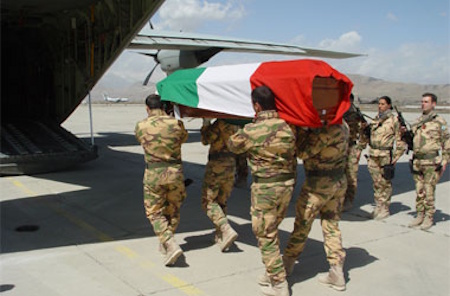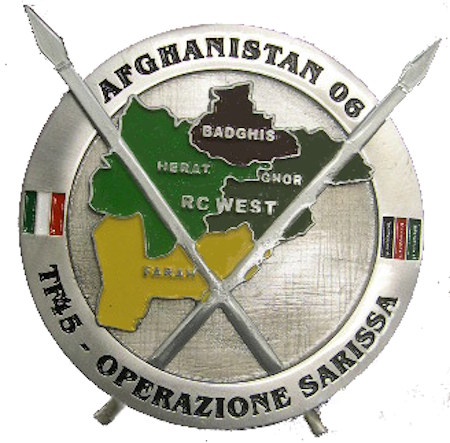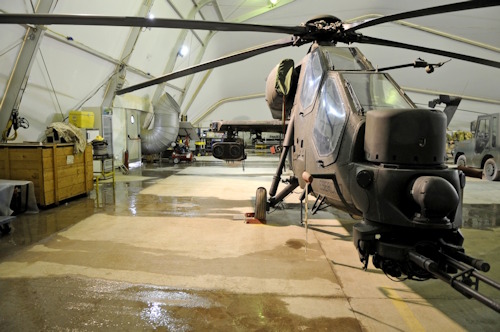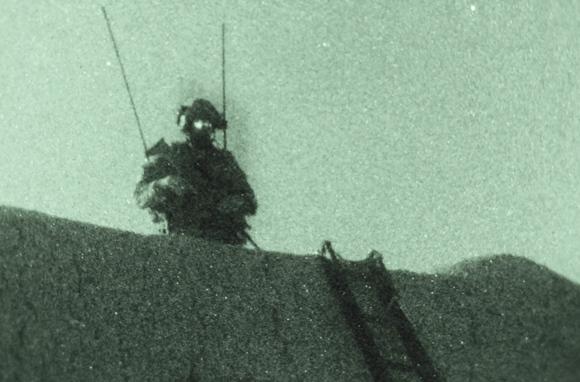With the 11 September 2001 terrorist attack on the Twin Towers, Operation Enduring Freedom (7 October 2001) was launched against Taliban militias in Afghanistan.
Italy sent a naval group to the Indian Ocean, led by the aircraft carrier GARIBALDI which also had elements of the Navy GOI on board.
The Americans had equipped the aircraft carrier KITTY HAWK (depriving it of fighters) as a platform for launching special operations - through the insertion of raiders by helicopters - into Afghan territory. After the Italian units were withdrawn, the GOI raiders continued to operate aboard the KITTY HAWK together with the Seal.
In December of the 2001 a detachment of the 9 ° Rgt COL MOSCHIN arrived, in the framework of the ISAF mission, with a role confined to the area of the Afghan capital.
In the 2003 the Berlusconi government took the decision to send a contingent, under Enduring Freedom (Nibbio 1 and Nibbio 2), of about 1000 men to Khost, near the Pakistani border.
Detachments of the GOI and the Nono operated jointly (in the 2004 the COFS was created at national level), according to a procedure destined to become recurrent. The first missions were planned and carried out in hostile territory, developing the most effective tactics for this particular context.
 The member of the special forces of Nibbio, placed inside the Salerno base, operated in a very difficult context, with an extremely complicated territory viability and an enemy who knew the territory and could count on safe bases.
The member of the special forces of Nibbio, placed inside the Salerno base, operated in a very difficult context, with an extremely complicated territory viability and an enemy who knew the territory and could count on safe bases.
For the first time our special forces found themselves operating in a challenging theater like the one in Afghanistan, where in the summer there are very high temperatures which, together with the high altitudes, put a strain on the physical resistance of our soldiers.
However, both operations were successful, without having to complain about losses (a certain nervousness was created when a detachment of acquirers found itself operating at 2 km from the Pakistani border). Once the two operational shifts ended, the Italian departments repositioned themselves again in Kabul, where the situation was considerably quieter.
But in Khost, instead, the situation precipitated, with numerous attacks by the Taliban militias, despite the massive interventions of the American contingent. As evidence that, perhaps, the Italian approach, characterized by less use of force and a greater use of diplomacy, was the most advantageous.
As mentioned, the ISAF mission focused exclusively on the Kabul area, while in the rest of the country Enduring Freedom acted. It was therefore a failure strategy, since, in such a large country, it would have been more appropriate to unify the missions, with a joint command.

It was decided that ISAF would operate throughout Afghanistan, divided into Regional Command.
Italy was assigned the command of the Regional Command West (RCW) based in the city of Herat.
It was in this period that the first fallen of the special forces had to be registered. Commander Vianini of the GOI, who died following a plane crash near Kabul on February 3 2005 (photo).
Very few are aware of the fact that the Italians and the British decided to create a command of the special forces of ISAF, the JSFC (with a command entrusted to a British person given the privileged relations with the US special forces) that could make use of the 42 Task Force (British ) and the 45 Task Force (Italian). The creation of a unified command represented further proof of London's esteem for our special forces.
The mission of the Italian special forces was called Operation Sarissa.
Work began on setting up a Task Force of Italian special forces capable of carrying out a wide range of missions against the Taliban militias.
The use of the TF-45 was decided by the Berlusconi government however, when the center-left came to power in the 2006, the organization of the unit and its deployment slowed down. The politicians of that area had a certain embarrassment to present this type of operation, so they decided not to make the unit public, denying its existence.
 This created a strong discontent among the operators of the Italian special forces, little inclined to be idle while the other contingents were engaged in hard fighting.
This created a strong discontent among the operators of the Italian special forces, little inclined to be idle while the other contingents were engaged in hard fighting.
The situation changed in the 2008, with the return to the government of the center-right team. From that moment the special forces could operate in a more dynamic way, increasing the activities and the area actually controlled, going as far as the remote Bala Murghab, at the northern end of Farah.
The organization and composition of the TF-45 responds to the availability of the departments that compose it (in the 2011 the COFS had to move departments for operations in Libya).
The TF-45 is divided into three components:
-
Herat command, where you can also find the logistic support.
-
ALPHA Task Group, composed entirely of operators of the 9 ° Assault COL MOSCHIN
-
BRAVO Task Group, composed of half by operators of the Ninth, while the other half by operators of the GOI, of the 17 ° Stormo Raiders of the Air Force and of the GIS of the Carabinieri.
The command is entrusted to an officer of the COL MOSCHIN, probably a major. Operators, given the very intense activity, have a 4 month theater shift.
Moreover the TF-45 could use the collaboration of the 4 ° Rgt Ranger MONTE CERVINO, inserted in the basin of the special forces, together with the 185 ° RRAO (TIER-1) from the 2017.
In Afghanistan the raiders had the task of identifying and neutralizing groups of hostile militiamen, who often hid among the civil population, for this it was necessary to conduct operations of surprise.

Immediately after the elimination of the hostiles, more substantial forces were needed to encircle the target, ensuring its safety with a larger number of men. Also in this case we need strong capacity for rapid intervention and considerable firepower, perhaps in very remote and difficult to access areas. This is why the MONTE CERVINE rangers represent an important resource for the complete success of special operations.
Our special forces beat the Afghan territory far and wide, making several contacts with the various militias. Obviously such an activity involves not a few risks. Initially the operators of the TF-45 moved on Land Rover VAV 4x4 and VM-90, subsequently the much more protected LMV LINCE 4x4 arrived, which offered greater security especially with regard to IED.
In addition to vehicle operations, the TF-45 raiders carry out helicopter actions, using the carriers supplied to the Armed Forces, such as the HH-101, HH-90 and CH-47.
Many times the detachments of the TF-45 have ambushed militia groups in areas that they considered safe.
In July of the 2010 a report came to the command of Herat about a strong gathering of hostiles in a village in the area of Baqua. It was decided to set up an elitransported operation, with branches formed by personnel from the Ninth, the GOI and the GIS.
The raiders were placed at dawn in the area of operation, with the support of two MANGUSTA attack helicopters).

In the village there were about 300 militiamen who began to open fire to defend their leaders (but also weapons depots).
The MANGUSTA intervened, especially with the 20 mm guns, while the TF-45 snipers began to eliminate the commanders and militiamen armed with rocket launchers and machine guns.
Eventually, on the ground, 75 remained enemies, while 12 were captured. The raiders had to register three wounded, immediately evacuated by MEDEVAC helicopters.
The Italian wounded are the only ones mentioned in the official statement, almost ashamed to have eliminated dangerous terrorists.
The same year, the death of the Lieutenant of the Ninth, Alessandro Romani, the first to fall in the ward of the 1993 must be recorded.
The 3 November 2011 a Taliban 5 commando hosted civilians 18 in an Esko International compound, located a short distance from Herat airport. The blitz of a detachment of the TF-45, formed by GOI and GIS operators, immediately started. With a textbook operation all the hostages were released, while the kidnappers were all killed.
It is certain that the TF-45 has conducted, during its activity, a huge number of missions in Afghanistan. Collecting more esteem and consideration from the Allies than from our own politicians.
Perhaps the words of the American general McCrystal, already commander of the allied forces in Afghanistan, would be sufficient to recognize the extraordinary commitment of these men: I observed the work and professionalism of the 45 Task Force and I believe that Italians should be proud of their soldiers.
Photo: US Army / Ministry of Defense / MoD UK












